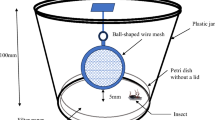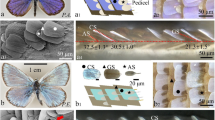Abstract
To evaluate high-power light-emitting diodes (HPLEDs) as potential attractants for Spodoptera Exigua adults, attractiveness of specific wavelengths, illuminance intensity, and light-exposure times were investigated and compared to that of fluorescent light. The white light (40 lux treatment) attracted significantly more S. exigua than other attractants. The optimal lightexposure time, based on the highest attraction rate, was 60 min. Evaluation of attraction and repellent rates under optimal conditions showed the white HPLED had the highest attraction rate (91.1%), and the red HPLED had the highest repellence rate (33.3%). Based on relative efficiency values, the white HPLED was about 9.14 times as efficient as the fluorescent light. These data clearly showed that S. exigua showed the greatest attraction to the white HPLED at 40 lux intensity and 60 min light-exposure time.
Similar content being viewed by others
References
Ahn YJ, Lee SB, Lee HS, and Kim GH (1998) Insecticidal and acaricidal activity of carvacrol and β-thujaplicine derived from Thujopsis dolabrata var. hondai sawdust. J Chem Ecol 24, 81–90.
Bentley MT, Kaufman PE, Kline DL, and Hogsette JA (2009) Response of adult mosquitoes to light-emitting diodes placed in resting boxes and in the field. J Am Mosq Control Assoc 25, 285–291.
Birscoe AD and Chitka L (2001) The evolution of color vision in insects. Annu Rev Entomol 46, 471–510.
Bishop AL, Worrall RJ, Spohr LJ, McKenzie HJ, and Barchia IM (2004) Improving light-trap efficiency for Culicoides spp. with light-emitting diodes. Vet Ital 40, 266–269.
Burkett DA and Butler JR (2005) Laboratory evaluation of colored light as an attractant for female Aedes aegypti, Aedes albopictus, Anopheles quadrimaculatus, and Culex nigripalpus. Fla Entomol 88, 383–389.
Chu CC, Jackson CG, Alexander PJ, Karut K, and Henneberry TJ (2003) Plastic cup traps equipped with light-emitting diodes for monitoring adult Bemisia tabaci (Homoptera: Aleyrodidae). J Econ Entomol 96, 543–546.
Hoel DF, Butler JF, Fawaz EY, Watany N, El-Hossary SS, and Villinski J (2007) Response of phlebotomine sand flies to light-emitting diode-modified light traps in southern Egypt. J Vector Ecol 32, 302–308.
Hogewoning SW, Trouwborst G, Engbers GJ, Harbinson J, Ieperen WV, Ruijsch J, Kooten OV, Schapendonk AHCM, and Pot CS (2007) Plant physiological acclimation to irradiation by Light-emitting diodes (LEDs). Acta Hort 761, 183–191.
Jongsma MA, Peters J, Stiekema WJ, and Bosch D (1996) Characterization and partial purification of gut proteinases of Spodoptera exigua Hü bner (Lepidoptera: Noctuidae). Insect Biochem Mol Biol 26, 185–193.
Jung MP, Bang HS, Kim MH, Han MS, Na YE, Kang KK, and Lee DB (2009) Response of ussur brown katydid, Paratlanticus ussuriensis to light-emitting diodes (LED). Kor J Environ Agric 28, 468–471.
Kang EJ, Kang MG, Seo MJ, Park SN, Kim CU, Yu YM, and Youn YN (2008) Toxicological effects of some insecticides against welsh onion Beet Armyworm (Spodoptera exigua). Kor J Appl Entomol 47, 155–162.
Kim DK (2001) Effect of juvenile hormone on metamorphosis and vitellogenesis of the beet armyworm, Spodoptera exigua. MS thesis, Andong National University, Andong, Korea.
Kim HH, Cho SR, Lee DW, Lee SM, and Choo HY (2006) Biological control of beet armyworm, Spodoptera exigua (Lepidoptera: Noctuidae) with Entomopathogenic nematodes (Steinernematid and Heterorhabditid) in greenhouse. Kor J Pestic Sci 10, 335–343.
Kishan RS and Thoma TW (2008) Responses of adult Plodia Interpunctella (Hübner) (Lepidoptera: Pyralidae) to light and combinations of attractants and light. J Insect Behav 21, 422–439.
Kordali S, Cakir A, Ozer H, Cakmakci R, Kesdek M, and Mete E (2008) Antifungal, phytotoxic and insecticidal properties of essential oil isolated from Turkish Origanum acutidens and its three components, carvacrol, thymol and p-cymene. Bioresour Technol 99, 8788–8795.
Maclntosh SC, Stone TB, Sims SR, Hunst PL, Greenplate JT, Marrone PG, Periak FJ, Fischhoff DA, and Fuchs RL (1990) Specificity and efficacy of purified Bacillus thuringiensis proteins against agronomically important insects. J Invertebr Pathol 56, 258–266.
Mutwiwa UN and Tantau HJ (2005) Suitability of a UV lamp for trapping the greenhouse whitefly Trialeurodes vaporariorum Westwood (Hom: Aleyrodidae). CIGR E-Journal, Manuscript BC 05 004.
Oh MS and Lee HS (2010) Development of phototactic test apparatus equipped with light source for monitoring pests. J Appl Biol Chem 53, 248–252.
Park IK, Lee HS, Lee SG, Park JD, and Ahn YJ (2000) Insecticidal and fumigant activities of Cinnamomum cassia bark-derived materials against Mechoris ursulus (Coleoptera: Attelabidae). J Agric Food Chem 48, 2528–2531.
Sengottayan SN, Kandaswamy K, and Kim S (2006) Effects of Dysoxylum malabaricum Bedd. (Meliaceae) extract on the malarial vector Anopheles stephensi Liston (Diptera: Culicidae). Bioresour Technol 97, 2077–2083.
Smagghe G, Pineda S, Carton B, Estal PD, Budia F, and Vinuela E (2003) Toxicity and kinetics of methoxyfenozide in greenhouse-selected Spodoptera exigua (Lepidoptera: Noctuidae). Pest Manag Sci 59, 1203–1209.
Tamulaitis G, Duchovskis P, Bliznikas Z, Breivë K, Ulinskaitë R, Brazaitytë A, Novièkovas A, and Žukauskas A (2005) High-power light-emitting diode based facility for plant cultivation. J Phys D-appl Phys 38, 3182–3187.
Wu MC, Hou CY, Jiang CM, Wang YT, Wang CY, Chen HH, and Chang HM (2007) A novel approach of LED light radiation improves the antioxidant activity of pea seedlings. Food Chem 101, 1753–1758.
Author information
Authors and Affiliations
Corresponding author
Rights and permissions
About this article
Cite this article
Oh, M.S., Lee, C.H., Lee, S.G. et al. Evaluation of high power light emitting diodes (HPLEDs) as potential attractants for adult Spodoptera exigua (Hübner) (Lepidoptera: Noctuidae). J. Korean Soc. Appl. Biol. Chem. 54, 416–422 (2011). https://doi.org/10.3839/jksabc.2011.065
Received:
Accepted:
Issue Date:
DOI: https://doi.org/10.3839/jksabc.2011.065




